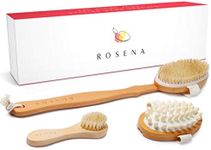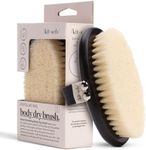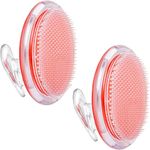Buying Guide for the Best Dry Body Brushes
Choosing a dry body brush can make a big difference in your skincare routine. Dry brushing is a technique that helps exfoliate dead skin, improve circulation, and may even help with lymphatic drainage. When picking a dry body brush, it's important to consider how it feels on your skin, how easy it is to use, and how well it fits your needs. Understanding the key features will help you select a brush that is comfortable, effective, and enjoyable to use.Bristle TypeThe bristles are the most important part of a dry body brush. They can be made from natural materials like boar hair or plant fibers, or from synthetic materials. Natural bristles are usually firmer and provide a more invigorating scrub, which is great for those who want deep exfoliation. Synthetic bristles tend to be softer and are a good choice for sensitive skin or beginners. When choosing, think about your skin sensitivity and how intense you want the brushing to feel. If you have delicate or easily irritated skin, go for softer bristles. If you want a stronger exfoliation, firmer natural bristles may be better.
Bristle FirmnessBristle firmness refers to how stiff or soft the bristles feel against your skin. Brushes can range from very soft to very stiff. Softer bristles are gentle and suitable for sensitive areas or for people new to dry brushing. Medium firmness is a good all-around choice for most people, offering a balance between comfort and effectiveness. Stiff bristles provide the most exfoliation and are best for tougher skin or those who are used to dry brushing. Consider your comfort level and skin type when deciding on firmness—if you’re unsure, starting with a medium firmness is usually a safe bet.
Handle DesignThe handle design affects how easy the brush is to use, especially when reaching your back or other hard-to-reach areas. Some brushes have long handles, which are great for reaching your back and legs, while others are palm-sized or have a strap, making them easier to control for smaller areas. If you want to brush your whole body, a long handle might be more convenient. If you prefer more control or want to focus on specific areas, a strap or handheld design could be better. Think about which areas you want to brush and choose a handle style that matches your needs.
Brush Size and ShapeDry body brushes come in different sizes and shapes, from large oval brushes to small round ones. Larger brushes cover more skin at once, making them efficient for full-body brushing. Smaller brushes are easier to maneuver and are good for targeted areas like joints or feet. The shape can also affect how comfortable the brush feels in your hand. If you want a quick, all-over brush, a larger size is helpful. For more detailed work or travel, a smaller brush might be more practical.
Material QualityThe overall quality of the materials used in the brush, including the bristles, handle, and any straps, affects durability and comfort. Brushes made from high-quality wood and natural fibers tend to last longer and feel better on the skin. Cheaper materials may wear out quickly or feel rough. If you plan to use your brush regularly, look for one with sturdy construction and comfortable materials. This will ensure a better experience and a longer-lasting product.
Ease of CleaningSince dry body brushes are used on your skin, it's important to keep them clean to avoid buildup of dead skin or bacteria. Some brushes are easier to clean than others, depending on the bristle type and how the brush is constructed. Brushes with removable heads or simple designs are usually easier to rinse and dry. If you want a low-maintenance option, look for a brush that can be cleaned easily and dries quickly to prevent mold or odor.














